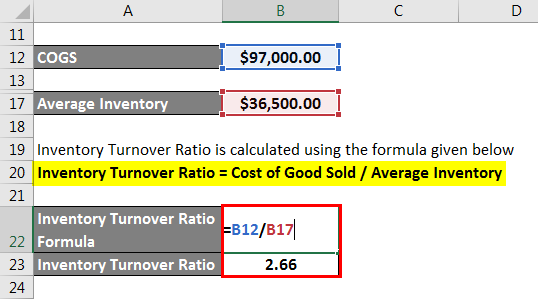

Inventory at the beginning of the year: $100 000
#Inventory turnover example how to
Example of How to Calculate Inventory Turnover On the other hand, using sales is very common and might be necessary for comparative analysis. Using COGS to find your inventory turnover is more accurate and realistic as it doesn’t include the markup. The average inventory can be found by dividing the sum of the starting and ending inventory values.

The Company’s balance sheet reports the inventory on hand. You can find Sales and COGS values on the income statement. The turnover ratio can be calculated by dividing sales or the cost of goods sold (COGS) with the average inventory. *Also known as days sale of inventory (DSI), days inventory outstanding (DIO), days inventory, inventory period, inventory turnover period, or simply average days to sell the inventory. If it can’t be sold, it’s worthless to your company and to potential business partners. Investors are interested in knowing how liquid your company’s inventory is and how fast you can turn it into cash. A decrease in inventory turnover means that stock is moving slower and you’re selling fewer goods are being sold or you’ve had to lower the markup rate for some reason. These numbers are important because they influence a significant source of your profit, the margin. Generally, a higher inventory turnover (but lower inventory turnover period) is preferred, but it varies from one industry to another. The DII value shows the average number of days it takes you to sell the current inventory on hand. Knowing how to calculate inventory turnover rate will help you to plan future inventory purchases and optimize your stock.ĭays In Inventory* (DII) helps you to understand inventory turnover even better because it puts the ratio into a daily context. This ratio indicates how many times the inventory is sold during a certain period of time - over a year, for example. It can provide them with a number of insights regarding their inventory management, specifically in relation to how efficiently it is being managed.Inventory turnover is a great indicator of how efficiently your company turns inventory into sales. This average can then be used as a baseline for future analyses.Īn inventory turnover ratio is a useful calculation for businesses to refer to.

However, it is important to first compare inventory turnover ratios of other similar firms in a given sector to determine what the average is. Higher ratios can be a positive indication of a business's performance. A higher ratio would match the increased speed at which such products are intended to be sold. This result can still be considered reasonably good for a sizable organization with a breadth of products across multiple niches.ĪBC Company’s inventory turnover ratio would not be as acceptable for a company that offers products meant for immediate consumption. By implication, the company's products remain in stock for a longer amount of time before being sold. In this example, ABC Company’s inventory turnover ratio is fairly low. This yields a result of 0.71, meaning that ABC Company sold 71% of its product inventory in the year.


 0 kommentar(er)
0 kommentar(er)
